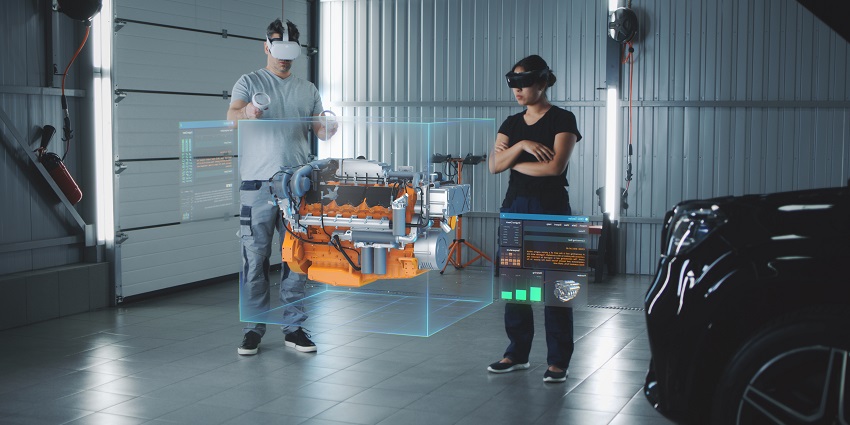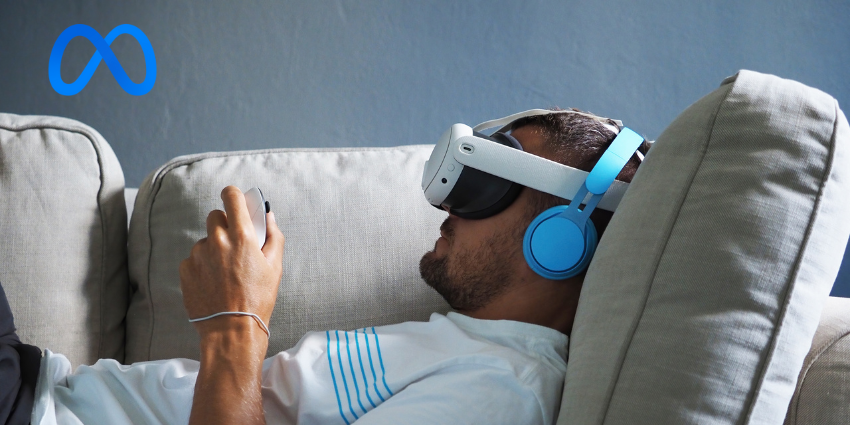Augmented reality kits seem to be everywhere, from well-known options like Apple’s ARKit and Google ARCore to Apple’s new collection of AR development tools. The simple reason is that demand for AR is growing at an incredible pace.
Valued at $57.26 billion in 2023, the AR market is now growing at a CAGR of 39.8%, thanks to evolving smartphone technology, Augmented smart glasses, and intuitive developer tools.
These days, you don’t necessarily need to be an extended reality expert to create your own augmented reality app. AR kits can streamline the development process, giving you all the necessary resources in one convenient bundle.
Here, I’ll introduce you to the benefits of AR kits and the top options you can explore in 2024.
What are Augmented Reality Kits?
Augmented Reality Kits (or AR Kits) are collections of libraries, frameworks, and tools that allow developers to build apps with AR capabilities. They can include features for everything from photo-realistic rendering to physics controls, animations, camera effects, and more.
Apple’s RealityKit and ARKit tools are probably the best-known examples. These tools give developers solutions for object capture and 3D modeling, custom shading, dynamic assets, object occlusion, and more, paving the way for enhanced AR experiences.
Compared to designing an AR application from scratch, kits offer benefits like:
- Ready-to-use features: AR kits come with pre-coded features you can embed into your apps, so you don’t need to design everything from scratch. For instance, you can use the Swift APIs in RealityKit to access all the features you need for an interactive app.
- Scalability: Augmented reality kits leverage multiple cores and CPU caches to deliver fluid physics simulations and visuals. They can automatically scale performance to different devices and wearables, giving you room to grow.
- Faster time to market: Instead of spending months developing features, you can easily integrate new solutions into your system, boosting time to market. Plus, you can take an agile approach to constantly adding new features and capabilities.
- Ease of use: AR kits come with extensive documentation, templates to help you design a custom experience, and access to broad communities you can share ideas with. This all simplifies the development journey.
The Top Augmented Reality Kits in 2024
As the augmented reality market continues to grow, new development kits, SDKs, and solutions are emerging all the time. Both technology vendors and XR innovators are investing in this landscape, and some are even extending beyond AR, into the mixed reality landscape.
For this guide, I’m focusing specifically on augmented reality kits. Since Apple’s VisionOS kit focuses on mixed reality, I’ll leave that solution out. However, I definitely recommend exploring the features if you want to take your AR solution to the next level.
Let’s dive into the options.
Apple ARKit
Apple’s ARKit is one of the most popular augmented reality kits available, particularly for developers focusing on mobile AR apps. The latest version of the kit includes support for 4K video, location anchors for various cities, image and video capture improvements, and an enhanced depth API with advanced scene understanding.
While the kit is tuned explicitly for developers building apps for Apple devices, it’s packed with a lot of incredible features, such as:
- Image and video capture, with the ability to capture high-resolution backgrounds.
- HDR video and EXIF tags for every ARKit frame
- 4K video streaming
- Depth APIs for realistic real-world blending
- Scene geometry for topological mapping
- A LiDAR scanner for plane detection
- People occlusion
- Motion capture with a single camera
Apple’s ARKit is free to use if you just experiment with the features. However, you’ll need an Apple Annual Developer Program account to deploy and publish apps for sale, which costs $99 per developer license.
Google ARCore
Google’s ARCore is the augmented reality SDK that combines various cross-platform APIs developers can use to build immersive experiences for Android, iOS, the web, and Unity. This open-source solution is free to use and supports a wide range of AR experiences.
You can leverage everything from persistent cloud anchors to streetscape geometry, powered by Google’s data, to create comprehensive immersive experiences. Some of the key features include:
- Motion tracking, showing positions relevant to the real world
- A geospatial API with content from Google Street View
- Anchors to track object positions over time
- Depth understanding, to measure the distance between surfaces
- Light estimation for shadows and illumination
- Recording and playback functionality
- Scene semantics with machine learning models
Like most augmented reality kits, ARCore comes with access to a range of documents, tools, and libraries that can be leveraged during development. Plus, there’s a fantastic community, and Google even hosts regular hackathon challenges for its developers.
Banuba Augmented Reality Kits
Banuba is a software company that designs solutions for the extended reality market. The company’s core offering is its cross-platform developer kit, which allows users to create apps with AR filters, picture-in-picture capabilities, video effects, and more.
The great thing about Banuba’s kits is they work seamlessly with various devices and existing developer tools, like Unity, Flutter, and ReactNative. Features include:
- Face and hand tracking, optimized for all devices
- 3D rendering and object creation
- Face segmentation neural networks (ideal for cosmetic apps)
- Background removers and video editing tools
- AR studios for creating custom filters
- Asset stores full of ready-to-use filters
- AI face analysis
There’s a 14-day free trial available for Banuba’s tools. After that, you’ll be given a custom subscription price based on the APIs and features you need to use.
Snap Lens Studio
Snap’s Lens Studio augmented reality kit is one of the first options I’d recommend for beginners. Although it doesn’t have the most advanced features, the toolkit constantly evolves, with new AI and machine learning capabilities and integrations for various development tools.
Lens Studio allows you to create content and filters for the Snapchat ecosystem, Spectacles AR glasses, and other web and mobile apps. It’s also extremely user-friendly and has its own creator rewards program for its community. Features include:
- High-speed content loading
- OpenAI ChatGPT filter creation
- Multi-project management
- Version controls, with integrations for GIT
- Cloth and material simulation
- Foot and face tracking
- Dedicated camera and spectacle kits
This kit is free to use and is ideal for creators, retail brands, and companies looking to connect with younger customers or create “try before you buy” experiences.
Meta Spark Studio
Another well-known option in this list of leading augmented reality kits, Meta Spark Studio, is a comprehensive platform for extended reality development. It allows developers to build and share AR experiences, starting with templates or designing custom code.
The Studio is ideal for companies creating augmented reality content for advertising and promotional purposes, as it integrates with the Meta ecosystem. Plus, it’s highly extensible, with options to add new APIs and create effects using JavaScript. Features include:
- Node-based or customizable visual programming
- Depth mapping and tracking
- Target, face, hand, and body tracking
- People and object occlusion
- Haptic integrations
- Performance tracking (with analytics)
- Unique background replacement options
- Augmented layers for metaverse projects
There’s also a handy mobile version of the augmented reality kit, Spark AR Go, which allows creators to develop, test, and publish experiences for Meta’s social platforms.
Unity AR Foundation
A little different from the other augmented reality kits I’ve mentioned, AR Foundation from Unity is a framework built for augmented reality development. It helps developers create augmented experiences once, which they can deploy across multiple mobile devices and wearables.
The Foundation unifies augmented reality kits from other companies, like the ARKit, Apple’s Vision Pro kit, Meta Quest, and AR Core, with unique Unity features. This means companies can combine all of the different solutions they need into a single ecosystem. Features include:
- Device, object, and image tracking
- Object and participant occlusion
- Face and body tracking
- Raycasting
- Anchors and environment probes
- XR interaction toolkits
- Integrations with Unity MARS for authoring
- Environmental understanding
- Light estimation
Unity’s AR Foundation toolkit is great for developers who want to extend the reach of their AR applications, creating multi-functional solutions that work across different devices.
Vuforia Engine
Leading technology company Vuforia offers developers the “Vuforia Engine” augmented reality kit. This combines all of the features experts need to build engaging 3D product demonstrations, design applications, and launch interactive marketing campaigns.
With advanced AI and computer vision technology, as well as support for a wide range of devices and platforms, Vuforia Engine is one of the most flexible augmented reality kits available. Features include:
- Model, area, image, and cylinder targets
- Leading computer vision powered by AI
- Ground and plane recognition
- CAD and IoT data integrations
- 3D modelling and object creation
- Libraries of pre-built solutions
- Virtual buttons
- Video playback
- Background effects
- Occlusion management
You can also choose to build your applications with Vuforia tools on existing development environments, like Unity and Android Studio. Developers can design experiences with the platform for free, then simply purchase a license when they’re ready to deploy.
Tips for Choosing the Best Augmented Reality Kits
Clearly, augmented reality kits come in a variety of different shapes and sizes, intended for specific use cases. The right solution for your team will depend on the kind of applications and experiences you want to build. However, there are a few things you should prioritize when making your choice:
- Compatibility: First, ensure your kit is compatible with the devices your customers will be using. Most kits support Android and iOS, but it’s worth looking for options that include support for wearables (AR smart glasses) and the web.
- SLAM: Simultaneous localization and mapping is a crucial feature for most augmented reality kits. It ensures your software can understand the position of 3D objects in the real world, allowing for cohesion between digital content and your environment.
- Object recognition: 3D object recognition is another core feature, which allows your software to recognize and respond to different objects. For example, Nissan’s AR app recognizes Nissan cars, and overlays information on top of those objects.
- Tracking: Tracking capabilities are crucial for creating a sense of immersion in AR apps. Hand and eye tracking are common, but some companies offer solutions for face tracking, body tracking, and individual finger tracking.
- Ease of use: It’s difficult to know just how complicated certain augmented reality kits are before you dive into the features. However, checking out product demos can give you an insight into the learning curve, and the structure of the user interface.
- Cost and license types: Some augmented reality kits are free to use until you want to publish content, like the Apple ARKit. Other companies charge either a single purchase price, or a monthly subscription fee to all developers.
Working with Augmented Reality Kits
Augmented reality kits streamline and simplify the process of creating immersive applications for a wide range of devices, wearables, and web experiences. As demand for augmented reality continues to develop, these kits offer companies an easy way to leverage the evolving market.
Of course, there’s no one-size-fits-all solution. All of the kits mentioned above are well-respected among developers, but they all have their own unique strengths and weaknesses. The right option for you will depend on the type of immersive content you want to create and share.
On the other hand, if you’re struggling with AR development, you could always consider working with a company that can create AR applications for you, like the leading XR entertainment agencies.







